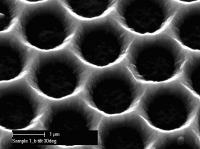An Oerlikon Solar team in Switzerland in collaboration with the photovoltaic team at the Institute of Physics at the Academy of Sciences of the Czech Republic has discovered an innovative design for a thin film solar cell that is low in silicon content, and may considerably increase efficiency.
Solar cells fabricated from amorphous silicon and microcrystalline silicon cells offer energy efficient, cost-effective and high-yield solutions.
Milan Vanecek, the photo-voltaic group head at the Institute of Physics in Prague, says that the disadvantage of these cells is that the stable panel efficiency is lesser than the panels fabricated from crystalline silicon cells that are wafer-based.
 Oerlikon ‘s Nanostructured ZnO Layer, Swiss cheese design for Micromorph solar cells
Oerlikon ‘s Nanostructured ZnO Layer, Swiss cheese design for Micromorph solar cells
To achieve stability of amorphous and microcrystalline silicon fabricated cells, they need to be designed very thin by dense packing between electrical contacts, and the optical absorption obtained does not suffice as they are planar. Amorphous silicon is 200 to 300nm thick, while microcrystalline silicon is more than one micrometer thick.
The design that has been developed concentrates on optically thick cells that absorb light even while being tightly packed together between the electrodes. The research paper has appeared in the Applied Physics Letters published by the American Institute of Physics.
The innovative three-dimensional design is based on the advanced absorber deposition technology of plasma-enhanced chemicals currently being deployed for amorphous silicon-based electronics used in liquid crystal displays. Vanacek stated that the discovery involved adding a nanostructured substrate to deposit the solar cell. This substrate comprises a collection of zinc oxide (ZnO) nano columns or a honeycomb of micro-pores or nano-pores etched into the conductive oxide layer (ZnO) that is transparent in nature.
Source: http://www.oerlikon.com